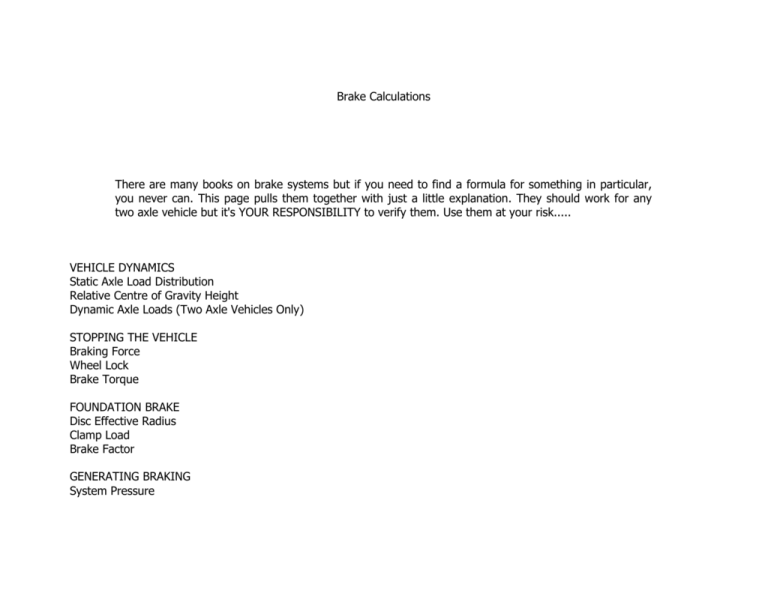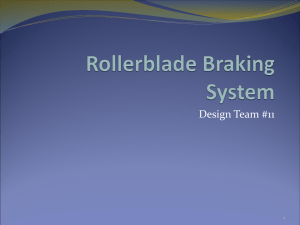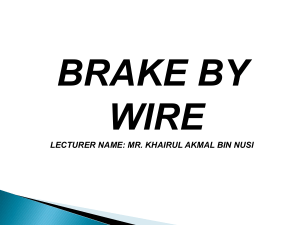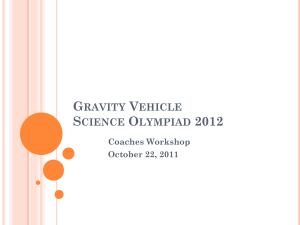Brake Calculations
advertisement

Brake Calculations There are many books on brake systems but if you need to find a formula for something in particular, you never can. This page pulls them together with just a little explanation. They should work for any two axle vehicle but it's YOUR RESPONSIBILITY to verify them. Use them at your risk..... VEHICLE DYNAMICS Static Axle Load Distribution Relative Centre of Gravity Height Dynamic Axle Loads (Two Axle Vehicles Only) STOPPING THE VEHICLE Braking Force Wheel Lock Brake Torque FOUNDATION BRAKE Disc Effective Radius Clamp Load Brake Factor GENERATING BRAKING System Pressure Servo Booster Pedal Force REAL LIFE DECELERATION & STOPPING DISTANCE BRAKE HEATING Stop Energy Kinetic Energy Rotational Energy Potential Energy Braking Power Dry Disc Temperature Rise Single Stop Temperature Rise Fade Stop Temperature Rise PARKING ON AN INCLINE Axle Loads Traction Force LOSSES FROM CABLE OPERATED BRAKES HYDRAULIC BRAKES Brake Fluid Volume Requirements Foundation Brake Requirements Pads Compressibility Rubber Hose Expansion Steel Pipe Expansion Master Cylinders Losses Fluid Compression DYNAMOMETER INERTIA ------------------------------------------------------------------------------------------------------ VEHICLE DYNAMICS Static Axle Load Distribution Note: this changes with the loading of the vehicle so laden and unladen figures are often different. BACK TO TOP Relative Centre of Gravity Height BACK TO TOP Dynamic Axle Loads (Two Axle Vehicles Only) The changes in axle loads during braking bears no relationship to which axles are braked. They only depend on the static laden conditions and the deceleration. Note: The front axle load cannot be greater than the total vehicle mass. The rear axle load is the difference between the vehicle mass and the front axle load and cannot be negative. It can lift off the ground though. (Motorcyclists beware)! BACK TO TOP STOPPING THE VEHICLE Braking Force The total braking force required can simply be calculated using Newton’s Second Law. BACK TO TOP Wheel Lock The braking force can only be generated if the wheel does not lock because the friction of a sliding wheel is much lower than a rotating one. The maximum braking force possible on any particular axle before wheel lock is given by: BACK TO TOP Brake Torque Having decided which wheels will need braking to generate sufficient braking force the torque requirements of each wheel need to be determined. For some legislation the distribution between front and rear brakes is laid down. This may be achieved by varying the brake size or more likely using a valve to reduce the actuation pressure. BACK TO TOP FOUNDATION BRAKE Disc Effective Radius The effective radius (torque radius) of a brake disc is the centre of the brake pads by area. For dry discs it is assumed to be: BACK TO TOP For full circle brakes it is: Note: the difference is because full circle brakes contact on the full face but caliper pads are not usually a quadrant but have square sides (Given the variability of friction the difference is not important in practice). BACK TO TOP Clamp Load The clamping load is assumed to act on all friction surfaces equally. For dry disc brakes it doesn’t matter whether the brake is of the sliding type or opposed piston. Newton’s Third Law state every force has an equal and opposite reaction and a reaction force from a sliding caliper is the same as an opposed piston one. BACK TO TOP Brake Factor Ball ramp brakes have a self servoing effect rather like a drum brake. The brake factor multiplies the output torque. BACK TO TOP > Brake Sensitivity High factor brakes become very sensitive to manufacturing tolerances and lining friction variations. A measure of sensitivity is the amount the brake factor varies for a change in lining friction. It can be calculated: BACK TO TOP GENERATING BRAKING System Pressure Pressure is a function of the required clamp load and the piston area. Remember on an opposed piston disc brake it’s only the area on one side of the disc. BACK TO TOP Servo Booster Servo characteristics are defined graphically. The output will have at least two slopes but will also have a dead band at the bottom. Pedal Force The pedal ratio is calculated to the centre of the foot pad. The pedal return springs may make a significant contribution to the overall pedal force. Especially at full travel. BACK TO TOP REAL LIFE DECELERATION & STOPPING DISTANCE The deceleration used in calculations is a steady state one called MFDD (mean fully developed deceleration). It assumes the vehicle is either braking or not. In practice it takes a time for the system pressure to rise and the friction to build up. This is not the driver reaction time but the system reaction time. Where a calculation requires a stopping distance or an average stop deceleration then this delay must be taken into account. For calculations a linear build up over 0.6 second is used ie 0.3 second delay. For testing the following graph show the requirements for 71/320/EEC and ECE R13. BACK TO TOP BRAKE HEATING Stop Energy The energy dissipated in a stop is the sum of energy from three sources, kinetic, rotational and potential. Kinetic Energy Assuming the stop is from the test speed down to zero then the kinetic energy is given by:- Rotational Energy The rotational energy is the energy needed to slow rotating parts. It varies for different vehicles and which gear is selected however taking 3% of the kinetic energy is a reasonable assumption. Potential Energy The potential energy is the energy gained or lost by stopping on a hill. BACK TO TOP Braking Power Only when the brake is applied (but rotating) is energy being dissipated in the brake system. Some of the stop energy is dissipated in the tyre as wheel slip. Managing the ideal wheel slip is the ultimate goal of ABS development but here assume 8%. The energy to each brake depend on the number of brakes and the proportion of braking on each axle. In order to calculate the power we need to know the brake on time: The power is then given by: This is the average power, the peak power at the onset of braking is double this. BACK TO TOP Dry Disc Temperature Rise These calculation are based on that given in the following reference: Brake Design and Safety 2nd edition by Ruldolf Limpert Single Stop Temperature Rise In order to approximate the temperature rise of the disc an assumption as to where the energy is going has to be made. Initially most of the heating takes place in the disc, however this can then be rapidly cooled by surrounding components and the air stream. The calculation assumes 80% goes to the disc. Heat flux into one side of the disc: Single stop temperature rise is: BACK TO TOP Fade Stop Temperature Rise The temperature rise after repeated stopping can also be approximated, although so many variables exist it is suggested this is only used for basic optimisation work. After a number of stops: BACK TO TOP PARKING ON AN INCLINE Axle Loads When parking on an incline the lower axle has a higher load than it does on the level. The rear axle load is the difference between the vehicle mass and the front axle load. BACK TO TOP Traction Force If the braked wheel is very light on an incline then it is possible the tyre will slip before the brake. Hill hold is usually required with the vehicle facing both up and down the hill. The traction force required to park the vehicle is: Where only one of the two axles is braked the limiting slope is: BACK TO TOP LOSSES FROM CABLE OPERATED BRAKES Cable losses are not inconsiderable and vary depending on the number and angle of bends. A typical cable supplier uses the following calculation to calculate cable efficiency: BACK TO TOP HYDRAULIC BRAKES Brake Fluid Volume Requirements When an hydraulic brake is applied fluid is required to move through the pipes. If the fluid source is a master cylinder it has a finite capacity. The following components need fluid:Foundation Brake Requirements Brake fluid is required to take up running clearance. It is also needed to compensate for lack of stiffness of the brake housing. For a disc brake the following approximation can be used: BACK TO TOP Pads Compressibility Pad compressibility varies between hot and cold conditions. Worst case figures are 2% cold and 5% hot at a pressure of 16MPa. The fluid required is given by: BACK TO TOP Rubber Hose Expansion The rubber hose expansion coefficient is usually taken as BACK TO TOP Steel Pipe Expansion Pipe expansion is very small and unlikely to be of interest however it should be noted that it is proportional to the cube of the diameter, so using bigger pipe than necessary on a system with a fixed fluid volume will cause longer travel for two reasons, the stiffness of the pipe and more importantly the additional fluid compression losses. BACK TO TOP Master Cylinders Losses Fluid losses in master cylinders increase with bore size and pressure. A reasonable assumption can be found by using the following: BACK TO TOP Fluid Compression Fluid compression varies with temperature and the type of fluid used. The fluid needed to take account of compression is calculated: It is usual to allow about 3% for trapped air in the circuits that can’t be removed by bleeding. This air is squashed totally flat during braking. BACK TO TOP DYNAMOMETER INERTIA When testing Brakes on a dynamometer it is important to calculate the inertia requirements. Many brakes do not run at the same speed as the wheels so it is important to understand how the brake will be mounted on the rig. Ignoring the inertia of the wheels the required dynamometer inertia is given by






